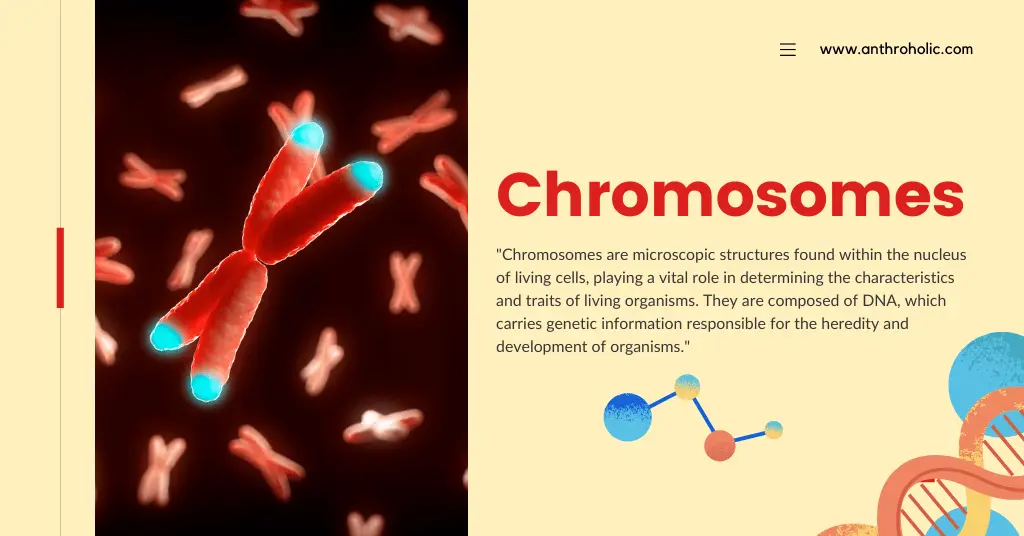AI Answer Evaluation Platform Live Now. Try Free Answer Evaluation Now
Chromosomes
Chromosomes are microscopic structures found within the nucleus of living cells, playing a vital role in determining the characteristics and traits of living organisms. They are composed of DNA, which carries genetic information responsible for the heredity and development of organisms.

Chromosome Structure and Composition
A. Chromosome Basics
Chromosomes are thread-like structures composed of DNA and proteins. They are found within the nucleus of eukaryotic cells and vary in shape and size, depending on the species. In humans, there are 46 chromosomes, organized into 23 pairs (Lodish et al., 2000). These pairs are classified into two types: autosomes (non-sex chromosomes) and sex chromosomes, which determine an individual’s gender.
B. DNA and Chromatin
The DNA molecule is a long, double-stranded helix consisting of nucleotide units, each containing a sugar molecule, a phosphate group, and one of four nitrogenous bases: adenine, thymine, guanine, and cytosine (Watson & Crick, 1953). Chromosomes are composed of a complex of DNA and proteins called chromatin. The primary proteins in chromatin are histones, which help to package the DNA into a more compact structure, facilitating its organization within the nucleus.
C. Chromosome Condensation
During cell division, chromosomes undergo a process called condensation, in which they become more tightly packed and organized. This process is essential for the proper separation of chromosomes during cell division, ensuring that each daughter cell receives the correct number of chromosomes.
| Species | Chromosome Number |
|---|---|
| Human | 46 |
| Chimpanzee | 48 |
| Fruit Fly | 8 |
| Garden Pea | 14 |
| Rice | 24 |
Functions of Chromosomes
A. Genetic Inheritance
Chromosomes serve as the vehicle for transmitting genetic information from one generation to the next (Mendel, 1865). Each parent contributes one set of chromosomes, resulting in offspring with a unique combination of traits. This process of genetic inheritance ensures the continuity of life and drives the evolution of species.
B. Gene Regulation
Chromosomes also play a crucial role in regulating gene expression. By packaging the DNA into chromatin, they help control which genes are accessible for transcription and translation, ultimately affecting the production of proteins and the overall phenotype of the organism.
Chromosome Abnormalities
A. Numerical Abnormalities
Numerical abnormalities occur when there is a change in the number of chromosomes, often due to errors during cell division. These can result in conditions such as Down syndrome, which is caused by an extra copy of chromosome 21 (Lejeune et al., 1959).
B. Structural Abnormalities
Structural abnormalities involve changes in the physical structure of chromosomes, such as deletions, duplications, translocations, or inversions. These can lead to various genetic disorders, including Williams syndrome and Cri-du-chat syndrome (Korenberg et al., 2000).
Latest Research
A. Gene Editing and Chromosome Engineering
Recent advancements in gene editing technologies, such as CRISPR-Cas9, have enabled researchers to manipulate chromosomes with unprecedented precision (Doudna & Charpentier, 2014). These techniques hold promise for the treatment of genetic disorders and the development of new therapies for various diseases.
B. Chromosome Dynamics and Cancer
Understanding the role of chromosome dynamics in the development and progression of cancer is an area of active research. Studies have shown that aberrations in chromosomal structure and number can contribute to the development of cancerous cells (Mitelman et al., 2007). Further research in this area may lead to new diagnostic tools and targeted therapies for cancer patients.
C. Telomeres and Aging
Telomeres are repetitive DNA sequences found at the ends of chromosomes that protect them from degradation and maintain chromosomal stability. Research has linked telomere length to aging and age-related diseases, such as cancer and cardiovascular disease (Blackburn et al., 2006). Ongoing studies are exploring the potential of telomere-modulating therapies to promote healthy aging and combat age-related diseases.
Conclusion
Chromosomes are essential for the survival, development, and evolution of living organisms. They carry genetic information that determines an organism’s traits and participate in the regulation of gene expression. Abnormalities in chromosome structure and number can lead to various genetic disorders and diseases. Recent research in this field has uncovered novel insights into the complex world of chromosomes and holds promise for the development of new therapies to treat genetic disorders and improve human health.
References
[1] Blackburn, E. H., Epel, E. S., & Lin, J. (2006). Human telomere biology: A contributory and interactive factor in aging, disease risks, and protection. Science, 314(5805), 1711-1715.
[2] Doudna, J. A., & Charpentier, E. (2014). Genome editing. The new frontier of genome engineering with CRISPR-Cas9. Science, 346(6213), 1258096.
[3] Korenberg, J. R., Chen, X. N., Hirota, H., Lai, Z., Bellugi, U., Burian, D., Roe, B., & Matsuoka, R. (2000). VI. Genome structure and cognitive map of Williams syndrome. Journal of Cognitive Neuroscience, 12(Supplement 1), 89-107.
[4] Lejeune, J., Gautier, M., & Turpin, R. (1959). Etude des chromosomes somatiques de neuf enfants mongoliens. Comptes Rendus Hebdomadaires Des Séances De L’académie Des Sciences, 248(11), 1721-1722.
[5] Lodish, H., Berk, A., Zipursky, S. L., Matsudaira, P., Baltimore, D., & Darnell, J. (2000). Molecular Cell Biology (4th ed.). W. H. Freeman and Company.
[6] Mendel, G. (1865). Versuche über Pflanzenhybriden. Verhandlungen des naturforschenden Vereines in Brünn, 4, 3-47.
[7] Mitelman, F., Johansson, B., & Mertens, F. (2007). The impact of translocations and gene fusions on cancer causation. Nature Reviews Cancer, 7(4), 233-245.
[8] Watson, J. D., & Crick, F. H. (1953). Molecular structure of nucleic acids: A structure for deoxyribose nucleic acid. Nature, 171(4356), 737-738.



